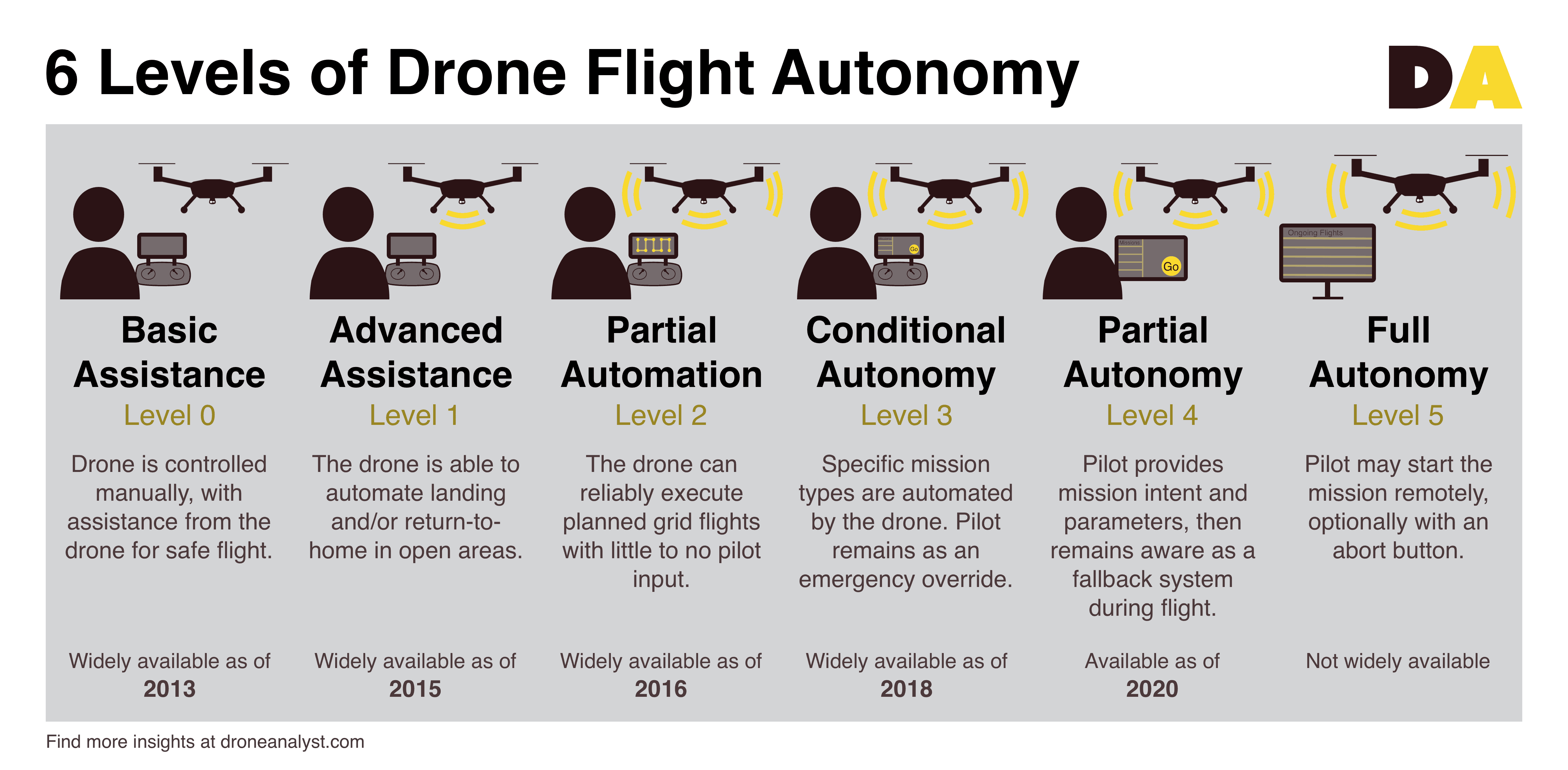As Talk of Automated Drones Increase, We Separate Fact From Fiction
Twitter spats pitting industry-leader DJI against innovative up-start Skydio have brought the discussion of drone autonomy to the forefront. There are debates over whose technology is best, the value of autonomy in general and whether or not current remote pilots should fear for their jobs.
None of these questions have an easy answer, and the topic of autonomy is increasingly complicated. We put this post together to help you understand what drone autonomy/automation really is and what impact it will have.
Current State of Flight Autonomy
When most first hear about drone automation, imaginations turn to the promise of autonomous drone flight. Many will recall ideas of a drone-in-a-box mapping sites daily, or a drone that deploys immediately once an emergency is called.
In the self-driving car world, the industry has worked around standards for driving automation systems set by the Society of Automotive Engineers (SAE). This has worked as a reference for DroneAnalyst’s own creation of 6 levels of drone flight autonomy (shown below). Although there is not yet a standard for the drone industry, it is a helpful reference for our discussion today.

You will note we use automation as a general term used to explain any automated action taken by the drone (or later on the software side), and autonomy as a more specific term for drone flights that are handled independently by the drone without detailed input from the pilot. There is a lot more we can discuss around terminology, and will be discussed in more detail in an upcoming blog post.
2020 has seen significant leaps for flight autonomy. Skydio’s 3D Scan solution marks the first solution to fulfil the Partial Autonomy (Level 4) requirements. There is a caveat to this, as the software is specific to a single application. With that in mind, Skydio only fulfils the Level 4 requirements for operators working solely in these applications.
Fact vs Fiction: Breaking Down Common Claims
Claim #1 Autonomous drones reduce training costs for larger drone programs
The argument for this claim is pretty simple – if my organization uses autonomous drones, we won’t have to train pilots, right?
There is truth to this in the long term, but it’s a bit more complicated today. To currently operate a drone – regardless of its capabilities – you need to carry a Remote Pilot’s license and have the ability to take control of the drone. Therefore, it doesn’t make sense to cut down on pilot training.
More importantly, drones today performing at Level 4 are relatively immature in the larger sphere of enterprise/government solutions. Organizations will wait to adjust their operations to account for them, and operate as normal until these products have a track record of safety across their own sites, with trained pilots on the sticks.
We do expect to see pilots hit the field more quickly as software handles more of the complex manoeuvres – although that benefit can be see from Level 2 automation and onwards.
There is a larger argument to be made that organizations will increase their investment in drone related training, regardless of the move to autonomy or not, as drone technology becomes more critical to their operations.
Claim #2 Autonomous drones are going to make Part 107 pilots redundant
Not so fast, previous DroneAnalyst research has shown Part 107 operators are primarily concentrated in the photography / videography sectors. Autonomous drones are able to track an object and take photos, which can help replace piloting skills for routine data capture missions. However, more creative and expressive applications will be better off with a highly skilled Part 107 (or equivalent) pilot.
In fact, we may likely see 107 pilots prefer more automated drones over less automated ones, so they can safely capture from risky angles and streamline their work. These benefits are already unlocked with Level 3 drones that accurately and safely record waypoints and “play back” flights.
The Part 107 pilots should see this as both a challenge and an opportunity. Drone pilots can’t expect to earn their wages by going to a site and pressing go – and that isn’t what is happening today. Pilots need to continuously upskill, whether that be going further into creative applications, building complimentary skills in drone engineering/maintenance/repairs or moving into drone program management/training/SOP development.
Claim #3 Autonomous drones will help ease regulatory concerns and more quickly attain advanced operation waivers
This one has logic and a track record to boot. Recently, through the deployment of Skydio drones, the FAA has allowed the North Carolina Department of Transportation to conduct Below Bridge BVLOS operations throughout their state.
And it makes sense. With autonomous drones, regulatory bodies like the FAA can more easily assess the risks associated with advanced operations by making the common denominator – behaviour of the flying aircraft – predictable. That means any operation with enough data and a standard approach, can be proven to be safe (or unsafe).
Claim #4 Autonomous drones are going to be the standard
The futurist in me says yes, that even where flights aren’t going to be handled autonomously it would be beneficial to invest in a drone that has the capabilities, but time will tell.
It really depends how the products and technology evolve. If autonomous drones are able to remain at competitive price points while bringing in different sensors and integrating with the right software, there is little reason for enterprises not not adopt them.
But that doesn’t mean pilots are going away, they just may be more of an operator/engineer/cameraman than a drone pilot. In fact, many enterprise pilots already have a “day job” with a full set of responsibilities and a career progression. Drones have just become part of that career progression, and the question of flight autonomy won’t significantly impact the economics behind their role.
Claim #5 The Drone Industry is Waiting for Autonomous Drones
While the promise of automated flights is exciting, I don’t see many applications waiting for autonomous drones. The barrier to entry for drone flight today – from a cost perspective – is already low. If it requires a business to have near 0 marginal costs of operation to adopt a technology, then it isn’t a valuable enough operation to spend the man-hours to automate it.
When reflecting on this claim, it’s interesting to take a look at the intelligent features DJI – the market leader and largest employer of drone engineers – has invested in with its new M300 platform. Nearly all of these features focus on streamlining the process of data capture and making missions more replicable or easier to execute by augmenting the pilot’s capabilities. These have the same benefits to users as improving flight autonomy, but more directly work within their current operating infrastructure and methods.
In summary, drones are becoming more efficient, and increased competition in the hardware space should hasten their development. Despite this, drone technology is sufficiently powerful that lack of full autonomy isn’t holding the industry back, but will make scaling faster.
The Full Drone Automation Stack

While much of this conversation has focused on drone flight autonomy, the topic is much larger in that automation has value across the broader drone workflow. While that might be hard to picture if you’re not working within a drone program, it starts by recognising that companies have already created sophisticated workflows and software to leverage their drone data.
In fact, many applications see the largest value in automating on the analysis side of their workflows.
Plant counts are a perfect example. Traditionally, farmers would either sample a small section of their farm or walk the entire field to get plant counts. This is time consuming, and capturing this data, whether that is with an autonomous drone or a Level 3 drone with a simple grid flight plan, is a fast, simple and safe option. But what has the largest marginal impact on the farmer’s time is running a image recognition algorithm to identify each plant and count them.
While this is a simple example, it extends to applications across nearly every industry that uses drones for mapping or inspection.
Where Will Drone Automation Be Most Impactful?
Drone autonomy has the largest impact in applications and missions that can be highly standardized, from flight to analysis . Inherently this lends itself well to inspection/maintenance and project/site management use cases across the Energy, AEC, Security, Infrastructure and Telecom industries.
How Should Your Business Plan Around Automation?
We recommend that new drone programs don’t get caught up around the complexities of automation, but instead focus on having a structured approach to every side of their drone program. That means developing rigid flight guidelines for each mission, documenting what to look for in your analytics and more.
These steps will inherently open up your drone program to automation in incremental steps as technology rises to meet your needs. Autonomous drones can more reliably fly a mission if you have already documented what a successful flight looks like and what data you require. AI and machine learning can better automate the analysis of the data if you are already collecting and categorizing your data in a structured, scalable way.
Learn More
For industry stakeholders looking to better assess how important autonomy is in the broader market, we have put together our 2020 Drone Market Sector Report that analyses the importance of autonomous features in driving drone purchases. This is just one of numerous insights found in the report. You can learn more about the report by clicking on the image below.

